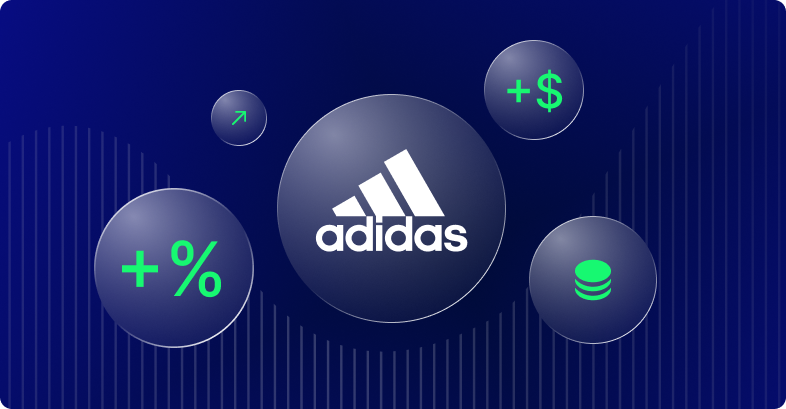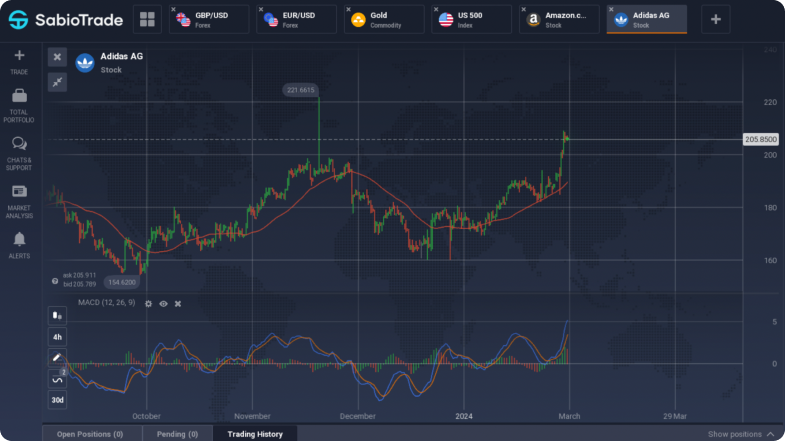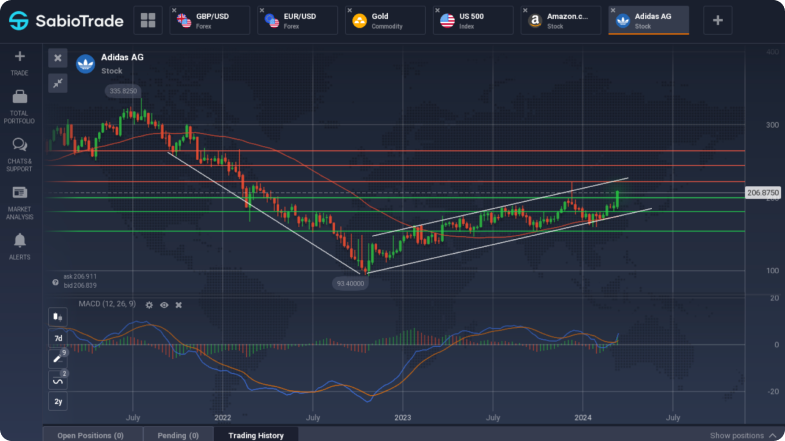Adidas AG Stock: Analysis and CFD Trading


Trading CFDs (Contracts for Difference) and Adidas securities has its own characteristics:
Like trading CFDs on popular stocks such as Amazon or Tesla, trading CFDs on Adidas AG gives you the opportunity to speculate on price movements without owning the underlying asset.
Adidas AG stands as a towering figure in the sportswear industry, renowned not just for its significant market presence but also for its relentless innovation and the creation of cutting-edge products. As the world’s second-largest sportswear manufacturer, Adidas has consistently demonstrated not only resilience in the face of market fluctuations and competitive pressures but also a remarkable capacity for growth and adaptation. This dynamic growth trajectory has rendered adidas’s stock a focal point of interest among investors and traders globally.
The company’s strategic initiatives, such as its commitment to sustainability, digital transformation, and direct-to-consumer sales channels, have further bolstered its market position. Adidas’s efforts to reduce its environmental footprint through the use of recycled materials in its products and its push towards digitalization to enhance customer experience are reflective of a brand that is not only forward-thinking but also responsive to global trends and consumer demands.

ADIDAS (ADS:ETR) 4H Graph
Financial Metrics and Stock Information:
| Metric | Value |
| ADS – adidas AG Share Price | €206.45 |
| Change | -0.05 (-0.02%) |
| Last Trade | Today at 08:30 UTC |
| Market Cap | €33.77bn |
| Enterprise Value | €38.12bn |
| Revenue | €22.51bn |
| Quality | 79 |
| Value | 14 |
| Momentum | 91 |
| StockRank™ | 68 |
| 1y Momentum | Subscribe to view |
| Relative Strength (%) 1m | +3.86% |
| 3m | -8.23% |
| 6m | -2.73% |
| 1yr | +11.83% |
| Volume Change (%) 10d/3m | -13.85% |
| Price vs… (%) 52w High | -4.86% |
| 50d MA | +6.33% |
| 200d MA | +7.28% |
| 12m Forecast Rolling PE Ratio (f) | 65.86 |
| PEG Ratio (f) | n/a |
| EPS Growth (f) | n/a |
| Dividend Yield (f) | 0.7% |
| Price to Book Value | 6.49 |
| Price to Tang. Book | 9.64 |
| Price to Free Cashflow | 25.88 |
| Price to Sales | 1.55 |
| EV to EBITDA | 37.6 |
Financial Metrics and Stock Information:Adidas shares are traded on the Frankfurt Stock Exchange (FSE) in the XETRA electronic trading system under the ticker ADS.
For the first time in 32 years, Adidas has reported an annual loss, marking a significant shift in the company’s financial performance. In 2023, the sportswear giant faced a €58 million loss, a stark contrast to its historical profitability dating back to 1992. Despite this setback, adidas has decided to maintain its dividend payments at €0.70 per share, signaling confidence in its financial strategy. The year proved challenging for Adidas’s CEO, Bjorn Gulden, particularly due to the fallout from ending the partnership with rapper Kanye West. This decision, made in late October 2022 amid a series of controversial statements by West, ended the production and financial ties with the Yeezy brand, which had been a significant contributor to Adidas’s product lineup since its launch in 2013.
Looking ahead to 2024, Adidas anticipates a 5% decline in sales in North America, its second-largest market. This forecast comes in the wake of a 21% sales drop in the region in the fourth quarter of 2023 and a 16% decrease over the entire year, attributed to reduced demand and an oversupply of inventory. However, Adidas is optimistic about a significant sales increase in China, expecting to rebound from the previous year’s challenges. The company aims to recover market share and achieve double-digit growth in the latter half of 2024, focusing on strengthening its core business excluding the Yeezy line. This strategy unfolds as Adidas’s competitor, Nike, announces a 2% workforce reduction, approximately 1,600 positions, as part of its cost-cutting measures, highlighting the broader challenges facing the sportswear industry amidst fluctuating consumer interest and market dynamics.

ADIDAS (ADR:ETR) Weekly Graph
On the weekly chart, we’ve identified support levels (green) and resistance levels (red) that merit attention. The price has been trading within an ascending channel since the beginning of 2023. The MACD suggests a potential continuation of the upward trend towards 221 (the upper boundary of the trading channel). The price is attempting to break through the 200 level for the third time in the last three months. The stock is trading above the MA(50), which also indicates a continuation of positive momentum in the medium term.
From an investment perspective, it would be prudent to wait for a retracement to the 200 support level before considering any purchases.
For investors keeping an eye on the sportswear sector, here’s the lowdown: adidas just hit a rough patch, marking its first loss in over three decades with a €58 million dip in 2023. Despite this, they’re holding dividends steady at €0.70 a share. The big story? North America’s not looking great for 2024, with a predicted 5% sales slump. But, Adidas isn’t throwing in the towel just yet. They’re betting big on a bounce-back in China and aiming for a solid rebound in the latter half of ’24, sidelining the Yeezy drama to focus on their main game. Meanwhile, Nike’s trimming its team to stay lean, cutting around 2% of its workforce. For those with skin in the game, it’s a pivotal moment. Adidas is looking to claw back market share in a tricky environment, signaling a potentially rocky but interesting path ahead for investors tuned into the sportswear saga.